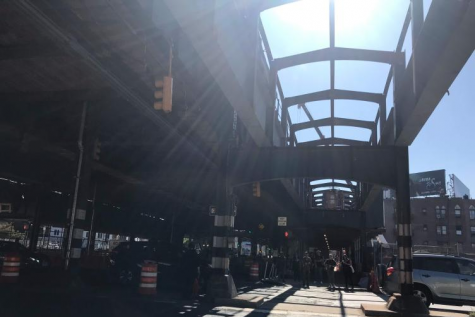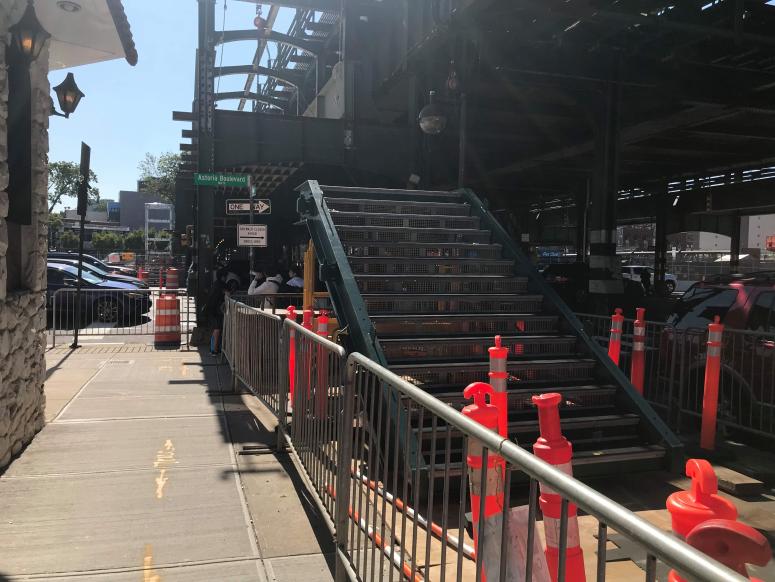MTA Improvements
Closed for renovations – This subway station is completely closed in order to install four new elevators and rebuild the station, and the addition of new wall art.
Most New Yorkers have taken some form of the public transit system at least once in their lives, and many of them take advantage of it almost every day. It’s how people get to work, to school, or meet up with friends — a large spider web network that connects people all across the city. It even has large groups of people who swear by it and absolutely adore it. However, one thing is for certain. There is massive room for improvement, and the government is finally doing something about it.
Governor Andrew M. Cuomo has officially declared that the subway system is in a state of emergency, and for good reason. Riders frequently complain about how the train is constantly late or delayed, the filth that permeates many of the stations, the overcrowdedness throughout the system, and so on.
A blueprint, created by subway leader Andy Byford, promises to completely modernize the systemwide dated equipment with modern signals to help improve train traffic direction, to have tracks changed out for newer ones, and to add almost two thousand new subway cars. But the improvements come with a staggering pricetag, fifty-two billion dollars.
Byford’s goal is to have the trains arrive to their stops on time more frequently, similar to the punctuality of the transit systems in Singapore, London, and Hong Kong. Other proposed improvements include more frequent heavy duty cleaning at the stations, as well as repainting and repairing tiles, service elevators, and escalators for better accessibility, as mentioned in ‘MTA Moving Forward.’ In addition, the MTA has organized to increase the amount of cars per train, with each new car holding approximately 145 riders, a massive jump from the original maximum capacity of 90. More specialized teams will be on hand to handle situations in which they were trained, and the interiors of cars will receive upgrades to improve the overall onboard experience. This has already been applied to several train stations in Astoria, Queens, such as the Astoria Boulevard station. Overall, it is an extremely ambitious plan.

Astoria Boulevard Station – The Astoria Boulevard stop is a hot spot for passengers of the N and W trains.
However, Governor Cuomo has been extremely hesitant to implement the plan due to its associated costs, and he has clashed with Byford on its intricacies. The MTA is already in debt, and though Byford was hired specifically to rescue the struggling subway system, colleagues fear that he may quit due to his frustration with the governor. The truth is, Byford does not believe that he has the necessary support from Cuomo in order to carry out the plan. On the other hand, Cuomo believes that Byford does not understand the governor’s role in the leadership of the project. Nevertheless, the governor will have to come to an agreement with the subway leader and raise the budget substantially, in order to prove his commitment to bettering the subway system.
Why is this plan so important to the riders of New York? The deteriorating conditions and quality of the stations have actually been recently deterring potential passengers from utilizing the trains.
Although the subway system has been in decline for years due to deferred maintenance issues, the subway has only improved marginally as of late, according to Bronx Science students.
“For the past few years, the subway was rarely on time, and the 6 train was always overcrowded during my morning commute. Since then, it has improved, but not by much,” Marina Shirky ’22 said. “The subways are less overcrowded sometimes, but still crowded. The trains don’t come often enough, and they rarely come when they say they will.” Shirky believes that having the trains arrive at their stations on time more often would make the riding experience more bearable.
Another student encapsulates the growing issue of the deteriorating state of the transit system. “The state of the subway system now reflects a growing problem in New York City. Fares are high, space is scarce, and everyone is frustrated,” said Giyun Hong ’21, a close to daily rider of the subway for the past five years. “You barely have any space for sympathy, let alone your backpack. Emotionally speaking, it is utterly exhausting. You lose your morale in some small aluminum box, and the delays don’t help,” Hong said.
While improvements will be arriving soon, New Yorkers must remain patient. But for now, please stand clear of the closing doors.
“For the past few years, the subway was rarely on time, and the 6 train was always overcrowded during my morning commute. Since then, it has improved, but not by much,” Marina Shirky ’22.
Alisha Wang is a Staff Reporter for ‘The Science Survey’ and a Groups Section Reporter for ‘The Observatory’ yearbook. She finds that rhetoric...
Pinkey Lam is the Managing Editor for ‘The Science Survey’ and her job is to ensure that deadlines are met so that the newspaper is ready for print...

